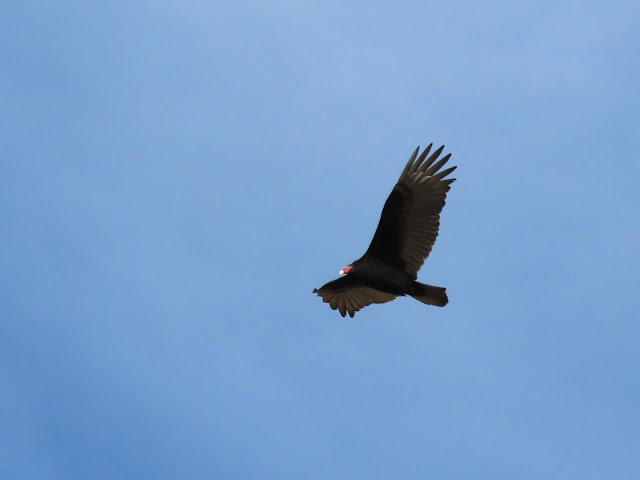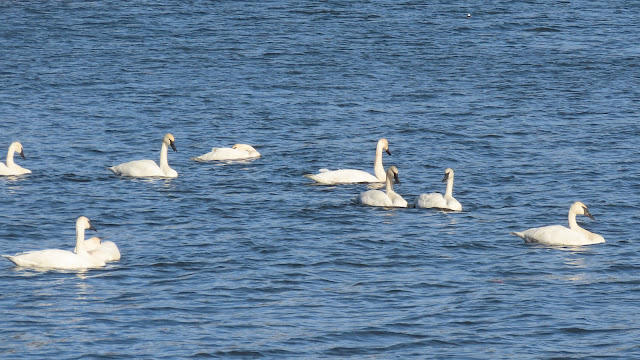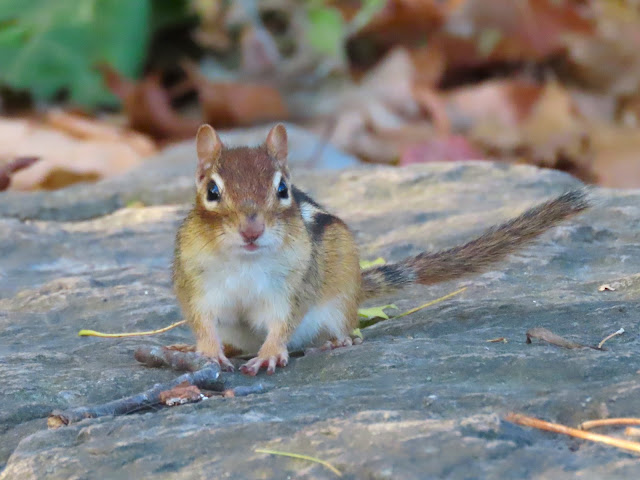15 November, 2023
DesJardins Canal, Dundas, ON
The signature winter bird at this location is Hooded Merganser (Lophodytes cucullatus), but they were few in number and reticent about showing themselves.
Common Teasel (Dipsacus fullonum) has an interesting history. It was originally introduced into North America in the 1700s for wool production.
The original intent has been long abandoned, but the plant is now a feature of landscapes throughout North America.
A Pied-billed Grebe (Podilymbus podiceps) was doubtless a late migrant, soon to be on its way.
Eastern Grey Squirrel (Sciurus carolinensis) - black morph shown here - has a mission in life, to irritate and enrage human feeders of birds, and to invade their attics if possible.
Urquart Butterfly Garden, Dundas, ON
A very accommodating Northern Mockingbird (Mimus polyglottos) posed for at least five minutes, enabling every camera lens to be pointed in its direction.
Grindstone Creek, Hamilton, ON
A few hardy Double-crested Cormorants (Nannopterum auritus) spend the winter here, more each year it seems.
A family of Trumpeter Swans (Cygnus buccinator) had decided to make Grindstone Marsh its winter quarters, at least for now, although the water is shallow at this location and freeze-up may necessitate a move to Lake Ontario.
Hooded Mergansers were on their best birder-pleasing behaviour and showed themselves in all their splendour.
This Ring-billed Gull (Larus delawarensis) bore bands on both legs, indicating perhaps that it is the subject of a study.
For no reason that we could determine the family of Trumpeter Swans seemed especially enraged at a single drake Mallard in their vicinity, and this hapless duck was chased away with much fanfare.
When the dreaded intruder had been soundly chastened and dispatched, this youngster looked especially smug I thought, as though some rite of passage had been accomplished with full marks.
A Great Egret (Ardea alba) seemed to be finding food up against the barrier of discarded Christmas trees used to block invasive (and destructive) Asian Carp.
Perhaps the fish congregate there having reached an impasse to their progress and the fishing is easy for a skilled hunter like a Great Egret or a Great Blue Heron (Ardea herodias).
Our familiar Blue Jay (Cyanocitta cristata) merits a second glance every time. It is a striking bird in every respect and I thought these pictures of it in an Eastern White Pine (Pinus strobus) were exceedingly pleasing, and emblematically Canadian.
Just a tree or so over was a Red-bellied Woodpecker (Melanerpes carolinus), equally stunning in its own special way.
There were several Cedar Waxwings (Bombycilla cedrorum) but they stubbornly refused to display themselves in an unimpeded fashion.
The song of a White-throated Sparrow (Zonotrichia albicollis) is often interpreted as Sweet Canada, Canada, Canada - and quite right too.
Fittingly for this location, one of the first birds we saw was a female Red-breasted Merganser (Mergus serrator).
LaSalle Park is always a good location to find American Coot (Fulica americana) in late fall and winter.
Usually, the head of a male Bufflehead (Bucephala albeola) appears black, but Miriam was able to capture the iridescence in this shot.
Redheads (Aythya americana) were present, but quite far offshore and mostly snoozing, head tucked under the wing.
These white Mallards are known by the name Pekin Duck or Aylesbury Duck and represent a strain raised by humans for meat and appearance.
From time to time they escape from captivity and join flocks of their wild congeners where they are readily accepted and become part of the flock. They are splendid birds and add a highlight to a birder's day.
This male seemed to have a deformed bill, but was coping adequately as far as we could tell.
LaSalle Park is a reliable spot to find American Black Duck (Anas rubipres), not always easy elsewhere.
Everyone who sees Common Goldeneye (Bucephala clangula) for the first time remarks that this is a bird that is descriptively accurate.
Ruddy Duck (Oxyura jamaicensis) is a very appealing little duck in the group known as Stifftails; cosmopolitan and extremely interesting.
For an excellent treatment of Stifftails (Oxyurini), the work by Paul A. Johnsgard and Montserrat Carbonell, Ruddy Ducks and other Stifftails, remains the best available, and anyone wishing to gain more insight into this group would benefit greatly from a study of this book.
One of the principal reasons to visit LaSalle Park is to bask in the glory of Trumpeter Swans and one never is disappointed.
Asian Lady Beetle (Harmonia axyridis), also sometimes known as Harlequin Lady Beetle, is a hardy insect, often found in late fall or even early winter.
A female Common Merganser (Mergus merganser) was one of the last birds we saw as we prepared to leave, to complete our sweep of the three "sawbills" for the day.
The harbour seemed to be devoid of birds as we entered and that proved to be pretty much the case.
We did, however, tally our only Long-tailed Ducks (Clangula hyemalis) for the day, exclusively females, however.
A Ring-billed Gull had caught a crayfish, and left some of us wishing that we too had lobster for dinner.
It had been a fine day - the only kind we ever have!
Until the next time.....
























































By strange coincidence, David (we jointly seem to have more than our fair share of them), I was photographing teasel yesterday.
ReplyDeleteAlthough I was, of course, aware of Aylesbury Duck as a menu item, I had no idea that it referred to the domesticated white form of Mallard.
That was, indeed, a very fine day that you had!
Best wishes to you and Miriam - - - Richard
It is very interesting what you write about Dipsacus, David. It was used for carding wool, and it has also been used for that here in Norway. Lovely picture of the black squirrel. Yes, all squirrels are skilled at robbing bird feeders, but they need food too. Beautiful picture of the Blue Jay.
ReplyDeleteHugs and kisses, Marit
I am not surprised that you knew of the historical uses of teasel, Marit. You are always well-informed.
Delete...David this was a delight collection to enjoy this morning, thanks.
ReplyDeleteBlue Jay always looks so elegant and beautiful. I have never in my life seen a grey (almost black) squirrel, just the brown one...nature is amazing!
ReplyDeleteThere are a couple in my backyard right now. Come on over!
DeleteA aprte de ese oxígeno puro, que suministra la naturaleza. Las imágenes que has capturado, son maravillosas.
ReplyDeleteFeliz domingo.
Hello,
ReplyDeleteBeautiful photos from your outings. I like view of the harbor and sky. Lovely captures of the birds, all the swans and the Goldeneye are favorites. Take care, have a great day and a happy new week!
Hola amigo David, precioso paseo en el que has visto numerosas aves acuáticas y pájaros, es una maravilla conocerlos.
ReplyDeleteMuchos besos y abrazos.
love woodpeckers...
ReplyDeletethey never visited our backyard for several years....
Thank you for sharing beautiful photos.
Woodpeckers and friendly backyards go together!
DeleteWe always called those cat tails! Now I know! You have had some magnificent sightings and I've been thoroughly enjoying your catch-up posts. All the swan photos are especially fabulous and of course I love the blue jay!
ReplyDeleteCattails are totally different, Jeanie, and grow only at the water’s edge.
DeleteThe yellow feet, the ruffled feathers on the swan, get special mention from the Mad one. Never seen a black squirrel and this one is cute. they are little devils, all of them, but oh so cute. ever wild critter does something humans don't car for, but I like them all. awesome photos of the jays. as always your photos are perfection. I am told even humans eat crayfish, but not me.
ReplyDeleteBeautiful birds. Fortunately, spring and summer will soon come to Finland as well. Migratory birds arrive.
ReplyDeleteAnother wonderful trip with you, thank you. I live near waterways and have seen quite a few of these birds, on fresh water. But I didn't identify them very well.
ReplyDeleteTeasels can still be used for carding wool, though they've been replaced by hand carders like mine or even by higher tech drum carders. It's a tribute to whoever thought of the process back when teasels were the only option, probably Neolithic times. The idea is to comb out the wool fibers from being a tangled mass to lying in one direction for spinning then weaving.
I am learning a lot about teasel I did not know before.
DeleteGreat photos as always. I do love the blue jays for the appearance but they're such noisy birds.
ReplyDeleteThey perhaps say the same thing of humans and their trucks and cars.
DeleteWonderful pictures! As always, thank you for sharing them. I was particularly pleased to see one of my favorite birds, the Blue Jay, among them. And that little chipmunk! Looking out my window this morning, I see a small flock of White-throated Sparrows at my front yard feeder. They have arrived!
ReplyDeleteBlue Jays are fabulous birds. We are about to go for a walk and I expect to see a few of them.
DeleteHari OM
ReplyDeleteJoyful... a delightful fix for this water bird nerd! YAM xx
Absolutely delightful. Again. Many thanks. Love the iridescence that Miriam captured, but that is the rule rather than the exception.
ReplyDeleteThe photos are always a joy to see, congratulations to Miriam and all others who take them. Thanks for sharing, hugs, Valerie xxxxxxx
ReplyDeleteThe real autumn atmosphere. Paradise of birds.
ReplyDeleteQuerido David siempre es muy agradable disfrutar de vuestros paseos, las aves son todas preciosas y tu comentario muy educativo. Muchas gracias y un fuerte abrazo para ti y para Miriam.
ReplyDeleteA few cormorants have been spotted around the island this year. This is a rare sighting in the winter here. We don’t see chipmunks this time of year either. They disappear underground for the worst of the winter. Great photos!
ReplyDeleteOur chipmunks go underground during the cold weather too, but they must not enter complete hibernation since they emerge during warm spells. Miriam and I just returned from a walk where we saw three American Red Squirrels scampering through the conifers, and a male Eastern Bluebird.
DeleteLovely pictures!....I have never seen black squirrels....very interesting!........Abrazotes, Marcela
ReplyDeleteUsed to put the teasel in a vase in the early 60's on top of the organ.
ReplyDeleteThe photos are very nice and always good to see white swans.
Teasles also were used to full fabrics, to turn cotton fabric to flannel fabric, to make a wool blanket more dense. A friend wanted to demonstrate turning cotton to flannel, so my b=i-l made her a card that we outfitted with teasles to use. Researching that tool, I learned that the teasles used in the 17 and 18th centuries in this country are now extinct. They were larger and more sturdy than the current thistle, which, nevertheless, work well enough.
ReplyDeleteThank you, Joanne. I keep learning more about this.
DeleteDavid, dear friend, good night!
ReplyDeletethese walks cheer the soul and the heart and always your posts have a touch of humor, they lack nothing.
Those enraged swans, dispatching the duckling... jaja, the swans are very severe!
Poetic photographs that make me happy.
Greetings and great week ahead,
nite, nite!
What a great series of photos from your trips.
ReplyDeleteI really like the Eastern Gray Squirrel, we don't have this species here just the red squirrel and the gray squirrel, nor in the part of the country where I live, there are no squirrels at all.
I also love seeing the Northern Mockingbird, Trumpeter Swans, the Blue Jay and the Red-bellied Woodpecker, species that we never see here.
Greetings Irma
Hi David – I see Richard's comment about the Aylesbury Duck as a menu item (or home one) … and also hadn't realised it's the domesticated white form of Mallard: live and learn. Do you know what the 'rings' mean on the gull's legs?
ReplyDeleteThose Trumpeter Swans were having a fine day … apparently – game, set and match … Blue Jay always scores … as too the woodpeckers – came to love them when I was over on Vancouver Island.
Miriam's photo of the iridescence on the male Bufflehead is beautiful … isn't it – great shot. I'm glad the Congener is surviving with its deformed bill … again a wonderful shot.
The Harlequin ladybird (as we call them) is a pest here to our native varieties … I wonder how many species imported for a seemingly good reason have escaped and now are pests – each continent has many: eg teasels in the US … also fascinating to know their original/ historical use - per Joanne ...
As you say – lovely days out … wonderful part of the world – mind you we have ours too. Cheers Hilary
I will probe a little deeper into the origins of the leg bands on the gull, Hilary, and see if I can come up with an answer. As to your final comment - indeed you do!
DeleteColorful Mallards always make me smile. LOVED the action photo you go of the swans giving chase. They sure had the advantage of numbers on their side.
ReplyDeleteSandy's Space
Always nice to see swans, and I love those mallard ducks with their green heads. I love that shade of green.
ReplyDeleteReally beautiful photos. My favorite is the cat tales. Have a very nice day today.
ReplyDeleteThere are no cat tales, nor cattails, yet there are teasels!
DeleteUrquhart, the same name of the castle that stands over the Loch Ness in Scotland.
ReplyDeleteAlways beautiful photos and many things to learn about the birds and other animals.
Thinking of lobster for dinner would have also been my reaction after seeing the successful crayfish catch by the gull, David. Thanks for your recent comment on my cold duck feet post. It was interesting to read who their feet do not get as cold as my own despite wearing wool socks!
ReplyDeleteGreat photo from Miriam catching the Trumpeter Swans chasing away the drake Mallard.
ReplyDeleteOne thing I have noticed from your winter photos David is a complete lack of snow - have you not had any yet? When my brother first moved to Canada 50 years ago snowfall seemed to begin in the Autumn and hang around for several months.
We have had very little snow this winter, Rosemary, and even that which has fallen melts quickly as one day after another is above freezing. I long for a good old-fashioned winter but it is perhaps a thing of the past.
DeleteIt does look indeed like a very fine day, David. I didn't know that teasel was originally introduced for wool production. We have a lot here as well and I love to take photos of it. The Eastern Grey Squirrel looks like a little rascal, the black color is very beautiful. Our Western Gray Squirrel stay gray, there is not much difference in color to see. But they're quite vocal when they're alarmed. Beautiful photos as usual, compliments to Miriam. Have a good week, David. Hugs - Carola
ReplyDeleteBeautiful photos. I like the photo of you both. Nice birds and squirrels in Canada.
ReplyDeletehello David
ReplyDeleteI understand very well that everyone describes the blue jay as a very beautiful bird, I completely agree with the green and when the swans start.. yes then it gets loud, again great information and photos
Greetings Frank
Another very enjoyable catch-up post.
ReplyDeleteBeautiful photographs, thank you.
All the best Jan
Nice catch up. Beautiful collection of ducks. Semi never heard of. Thanks for the info and for sharing. Enjoy the rest of your week.
ReplyDeleteI felt very comfortable here with you again.
ReplyDeleteThanks for the wonderful photos,
dear David to you, to Miriam and everyone else.
I currently have a flock of sparrows at the birdhouse, blue tits, great tits and blackbirds. The blackbirds insist on their territory and drive away every member of their species, but the sparrows and tits let them have their way. Every now and then a forest bird comes and then I'm particularly happy that I can see it up close.
We have the great spotted woodpecker and the black woodpecker in the forest. The red-bellied woodpecker has a beautiful grain, thank you also for this beautiful photo.
The birds are already quite lively here... I think spring isn't very far away...
A happy greetings from Viola
Thanks for this lovely comment, Viola. Black Woodpecker is a bit of a nemesis for me. I have searched for it in Europe several times, but the best look I had was of a bird flying rapidly and quite high overhead. I think that will have to do!
DeleteSiempre encantada de pasear contigo querido amigo. Abrazos.
ReplyDeleteFantastic captures!
ReplyDeleteI loved the photos of the Blue Jay, it's such a beautiful bird.
Wow, great are the Mergasers and ducks!! But al the birds are fantastic. Lucky you to see so many species!
ReplyDeleteGreetings, Maria ( you see I am also busy catching up ;-)